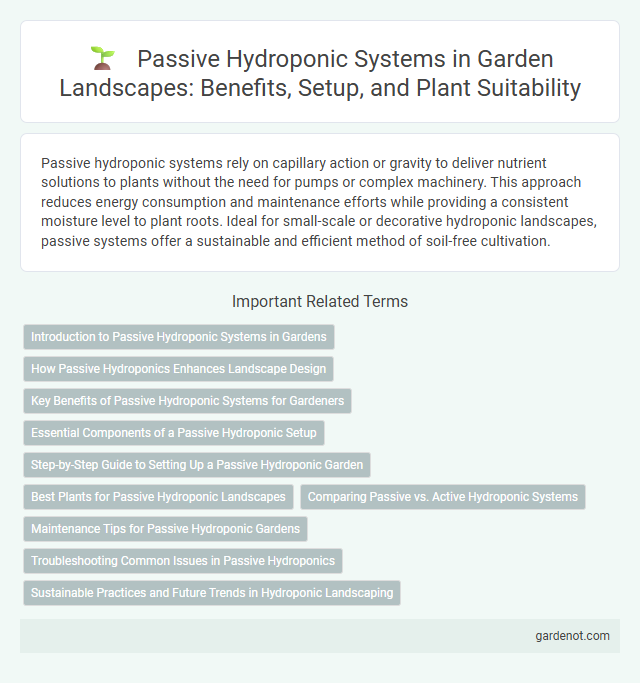Passive hydroponic systems rely on capillary action or gravity to deliver nutrient solutions to plants without the need for pumps or complex machinery. This approach reduces energy consumption and maintenance efforts while providing a consistent moisture level to plant roots. Ideal for small-scale or decorative hydroponic landscapes, passive systems offer a sustainable and efficient method of soil-free cultivation.
Introduction to Passive Hydroponic Systems in Gardens
Passive hydroponic systems in gardens utilize natural capillary action and gravity to deliver nutrient solutions to plants without the need for pumps or electricity, making them energy-efficient and low-maintenance. These systems often feature porous grow media such as coconut coir, perlite, or rock wool that retain moisture and nutrients, ensuring consistent supply to plant roots. Ideal for small-scale or home gardeners, passive hydroponics support healthy plant growth by maintaining steady hydration and nutrient availability with minimal intervention.
How Passive Hydroponics Enhances Landscape Design
Passive hydroponics enhances landscape design by providing a soil-free growing system that supports cleaner, more sustainable environments and reduces maintenance needs. This method uses water-retentive substrates like LECA or coco coir to deliver consistent moisture and nutrients, promoting healthier root development and vibrant plant growth. The integration of passive hydroponic systems allows for innovative, space-efficient designs that combine aesthetic appeal with ecological benefits in urban and indoor landscapes.
Key Benefits of Passive Hydroponic Systems for Gardeners
Passive hydroponic systems offer gardeners efficient water and nutrient delivery through capillary action, reducing the need for frequent maintenance. These systems enhance plant growth by providing consistent moisture levels and oxygen to roots, minimizing the risk of root rot. Ideal for indoor and small-scale gardens, passive hydroponics promotes healthier plants with lower resource consumption and simplified setup.
Essential Components of a Passive Hydroponic Setup
A passive hydroponic setup relies on key components such as a nutrient reservoir, an inert growing medium like clay pellets or coconut coir, and a wicking system that transports nutrient solution to plant roots through capillary action. Oxygenation is naturally maintained by the exposure of roots to air within the growing container, eliminating the need for pumps or aerators. This simple, low-maintenance configuration optimizes root hydration and nutrient uptake, making it ideal for small-scale hydroponic landscapes.
Step-by-Step Guide to Setting Up a Passive Hydroponic Garden
Setting up a passive hydroponic garden begins with selecting a suitable container and ensuring it is watertight to prevent leaks. Next, place a growing medium such as clay pellets or coconut coir that retains moisture yet provides adequate aeration for root development. Finally, position the plants carefully and maintain nutrient-rich water in the reservoir to allow roots to absorb nutrients passively through capillary action.
Best Plants for Passive Hydroponic Landscapes
Best plants for passive hydroponic landscapes include pothos, spider plants, and philodendrons due to their adaptability and low maintenance requirements. These species thrive in moisture-rich environments without frequent nutrient adjustments, making them ideal for passive hydroponic systems. Their robust root structures efficiently absorb water and nutrients, ensuring vibrant growth and minimal intervention.
Comparing Passive vs. Active Hydroponic Systems
Passive hydroponic systems rely on capillary action and gravity to deliver nutrients to plants without pumps or mechanical equipment, resulting in lower energy consumption and reduced maintenance compared to active systems. Active hydroponic setups utilize pumps and aeration to circulate nutrient solutions, providing better oxygenation and faster nutrient delivery, which can enhance plant growth rates. While passive hydroponics offers simplicity and cost-effectiveness ideal for small-scale or indoor landscapes, active systems support higher yields and scalability for commercial hydroponic farming.
Maintenance Tips for Passive Hydroponic Gardens
Passive hydroponic gardens require consistent monitoring of water levels to prevent root dehydration and ensure nutrient availability. Cleaning the reservoir regularly helps avoid algae growth and root rot, promoting plant health. Using inert growing media like clay pellets necessitates periodic flushing to remove salt buildup and maintain optimal pH balance.
Troubleshooting Common Issues in Passive Hydroponics
Common issues in passive hydroponics include root rot, nutrient imbalances, and inadequate oxygen supply. Monitoring water quality and ensuring proper wicking from the nutrient solution to the plant roots can prevent stagnation and promote healthy growth. Regularly checking moisture levels and adjusting the medium helps maintain optimal conditions for plants in passive hydroponic systems.
Sustainable Practices and Future Trends in Hydroponic Landscaping
Passive hydroponic systems utilize natural capillary action and gravity to deliver nutrients without electrical pumps, reducing energy consumption and promoting sustainable landscaping practices. These systems minimize water waste and decrease reliance on artificial inputs, supporting eco-friendly urban greening solutions. Future trends include integrating biodegradable growth mediums and advanced sensor technology to optimize passive hydroponic efficiency and scalability in landscape design.
Passive hydroponic Infographic

 gardenot.com
gardenot.com